All in one 1
| Time |
09:00~17:30 (Lunch included) |
Price |
KRW 87,000/Per
(Min. 1 Pax) |
| Itinerary |
Hotel  Driving the famous Landmarks City hall / Cheonggyecheon / Gwanghwamun Plaza / Insadong / Jogyesa Driving the famous Landmarks City hall / Cheonggyecheon / Gwanghwamun Plaza / Insadong / Jogyesa  Changing of the Guard Changing of the Guard  Gyeongbok Palace Gyeongbok Palace  National Folk Museum National Folk Museum  Pass by the presidential Blue House Pass by the presidential Blue House  Red pine or Ginseng Center Red pine or Ginseng Center  Lunch Lunch  Changdeok Palace (Bukchon Hanok Village on Mon) Changdeok Palace (Bukchon Hanok Village on Mon)  Red pine or Ginseng Center Red pine or Ginseng Center  Insadong Insadong  Namdaemun Market Namdaemun Market  Hotel Hotel |
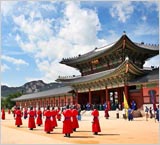
|
The Royal Guard Changing Ceremony
In ancient times' the royal guards of Joseon Dynasty performed the given task by guarding the Gwanghwamun Gate' the entrance of Gyeongbokgung Palace. The reenactment of the original ceremony began from 1996. The gate guardsmen perform the changing of the guards and hold a parade. The guards' uniforms' weapons' and accessories as well as their strict ceremonial procedures catch the eyes of people' especially foreign tourists' when guardsmen perform the changing of guards in traditional costumes at the main gate of Gyeongbokgung Palace in downtown Seoul. Be sure to bring a camera to take lots of pictures. |
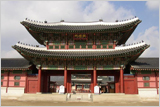
|
Gyeongbok Palace
The palace was originally constructed in 1394 by King Taejo and "Gyeongbokgung" was named by minister Jeong Do-jeon. Gyeongbokgung was continuously expanded during the reign of King Taejong and King Sejong the Great' but part of the palace was burnt down during the Japanese invasions of Korea (1592-1598). . |
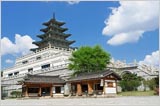
|
The National Folk Museum
The National Folk Museum of Korea' located in Gyeongbokgung Palace' features aspects of both the traditional folk culture of ordinary people and that of the aristocracy' centering particularly on the Joseon Dynasty (1392-1910). Devoted to the study' collection' and preservation of folk artifacts' it is also a forum for social education on folk culture through exhibitions and classes' which are designed to provide a better understanding of traditional Korean culture. |
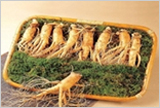
|
Pine Essential Oil or Ginseng Center
Visit either the pine essential oil or ginseng center and learn about the benefits of these Korean-made products. |
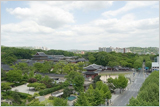
|
Changdeok Palace
Changdeokgung was the second palace after Gyeongbokgung which had been established in 1395 as a primary palace. In the midst of strife for the throne between princes and vassals, authority of Gyeongbokgung was deteriorated. King Jeongjong enthroned by Prince Yi Bang-won moved the capital to Gaegyeong, the one of Goryeo dynasty, again in 1400 on the pretext of superior geographical features of it in fact in order to avert the power struggle. Taejong(Yi bang-won) soon taking over the throne returned to Hanseong(present-day Seoul) had a new palace named Changdeokgung instead of Gyeongbokgung because he had killed his half brothers in Gyeongbokgung whose construction was led by Jeong Do-jeon the king's rival before. Construction of Changdeok Palace began in 1405 and was completed in 1412. King Seonjo expanded the palace grounds by about 500,000 square meters including Huwon (see below). The Palace was burnt to the ground during the Japanese invasion in 1592 and reconstructed in 1609 by King Seonjo and King Gwanghaegun. The next arson was in 1623 because of King Injo Political Revolt against Gwanghaegun. The palace was also attacked by the Manchu Qing but throughout its history of reconstruction and repair has remained faithful to its original design. Changdeokgung was the site of the royal court and the seat of government until 1872 when the neighboring Gyeongbokgung was rebuilt. Korea's last Emperor, Emperor Sunjong lived here until his death in 1926. |
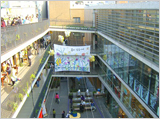
|
Insadong
Insadong has been at the heart of the nation's capital for 600 years and it has been the center of culture since the time of the Joseon Dynasty (1392-1910). Insadong was once known as 'Mary's Alley,' and is a favorite shopping spot among foreigners. Over forty percent of the nation's antique stores are in Insadong. There are a variety of art works from earthenware of the Unified Silla Era to white pottery of the Joseon Era. |
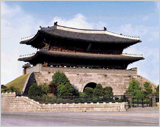
|
Namdaemun Market
Namdaemun Market is a large market in Seoul' South Korea. The market is located next to Namdaemun' which means "Great Southern Gate'" and was the main southern gate to the old city. Namdaemun market is one of the oldest continually running markets in South Korea' and it is the largest retail market in Seoul. Much of the market is outside' but there are also many stores which line the streets. Many retailers buy their items' particularly clothing' at wholesale prices at Namdaemun' to resell in their own stores in other cities. Namdaemun is a popular tourist attraction' but most of the customers are Korean. |
All in one 2
| Time |
09:00~17:30 (Lunch included) |
Price |
KRW 96,000/Per
(Min. 2 Pax) |
| Itinerary |
Hotel  Driving the famous Landmarks City hall / Cheonggyecheon / Gwanghwamun Plaza / Insadong / Jogyesa Driving the famous Landmarks City hall / Cheonggyecheon / Gwanghwamun Plaza / Insadong / Jogyesa  Changing of the Guard Changing of the Guard  Gyeongbok Palace Gyeongbok Palace  National Folk Museum National Folk Museum  Pass by the presidential Blue House Pass by the presidential Blue House  Redpine or Ginseng Center Redpine or Ginseng Center  Lunch Lunch  Korean Folk Village Korean Folk Village  The Korean Traditional Performance(The Korean Performance Will be canceled on a rainy day) The Korean Traditional Performance(The Korean Performance Will be canceled on a rainy day)  Redpine or Ginseng Center Redpine or Ginseng Center |
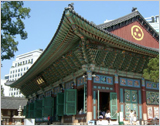
|
Jogye Buddhist Temple
Jogye Temple as the representative temple of the Korean Buddhism is the place of Boddhisattvas compassionated mind to seek living all together in the world. Its main hall Great Hero Hall is always open to welcome anyone of various nationalities and religions that would be come to pray or participate in worship. It has become famous for opening its space to participate Buddhist events. It was established in1910 and called as Gakhwang temple. In 1954 it was renamed as Jogyesa the only traditional temple located inside the boundary of four gates built during Chosun Dynasty in Seoul. |

|
The Royal Guard Changing Ceremony
The palace was originally constructed in 1394 by King Taejo and "Gyeongbokgung" was named by minister Jeong Do-jeon. Gyeongbokgung was continuously expanded during the reign of King Taejong and King Sejong the Great' but part of the palace was burnt down during the Japanese invasions of Korea (1592-1598). |

|
Changdeokgung Palace
Changdeokgung Palace is surrounded by trees and abuts a wooded hillside on the northern fringe of Seoul. By almost everyone's estimation, Changdeokgung is the most beautiful and best preserved among Seoul's half dozen palaces. Indeed, the historical significance of the palace and the adjacent "Secret Garden" were underestimated until designated as a UNESCO World Heritage Site. |

|
The National Folk Museum
The National Folk Museum of Korea' located in Gyeongbokgung Palace' features aspects of both the traditional folk culture of ordinary people and that of the aristocracy' centering particularly on the Joseon Dynasty (1392-1910). Devoted to the study' collection' and preservation of folk artifacts' it is also a forum for social education on folk culture through exhibitions and classes' which are designed to provide a better understanding of traditional Korean culture. |
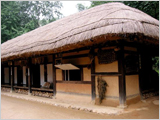
|
Korean Folk Village
The Korean Folk Village which vividly recreates the lifestyle of the Joseon Period is nestled 41 kilometers south of Seoul where clear streams flow through lush forests. The total area of 66,550 square meters embraces a government office a forge a pottery kiln a village school a rice cake shop and a 99-room nobleman's residence. It also contains about 270 farmhouses that feature the characteristics of each region. |
Contact for
English / Chinese / Japanese